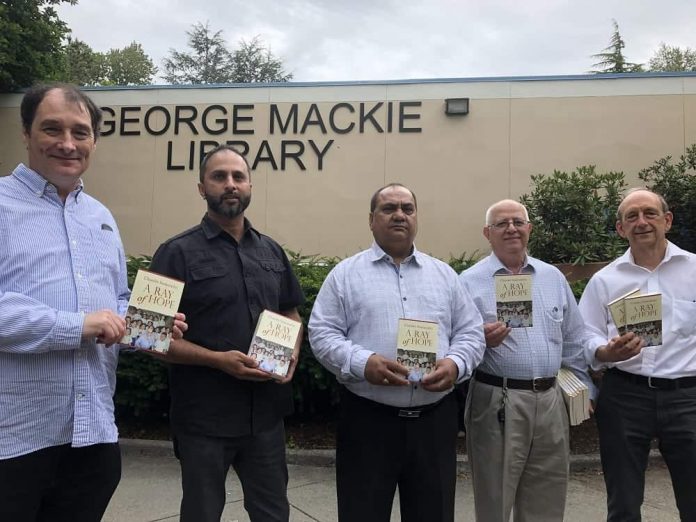THE autobiography of a philanthropist who lost his wife and two children in the 1985 Air India bombing was released in Delta last Sunday (June 24).
Ray of Hope is the memoir of Dr. Chandra Sankurathri whose wife Manjari, son Srikiran and daughter Sarada were aboard the ill-fated Air India Flight 182 when a bomb exploded mid-flight on June 23, 1985, killing all 329 people aboard. The aircraft was en route from Canada to India.
This was the worst attack in the history of aviation terrorism before 9/11. Widely blamed on the Sikh separatists seeking revenge for the repression of Sikhs in 1984, the attack had turned Sankurathri’s life upside down. Yet, turning his grief into strength, Sankurathri established a foundation in memory of his wife in her native city of Kakinada, Andhra Pradesh, in India.
The Manjarai Sankurathri Memorial Foundation currently runs a free school and an eye hospital for the poor and needy. Whereas, the school is named after his daughter whose dream of going to school was shattered as she was only four, he named the hospital after his son.

Photo by Babukishan Dass
The memoir was released at George Mackie Library in his absence by other Air India victims’ families and friends and two prominent journalists Charlie Smith, Editor of Georgia Straight, and Robert Matas, former reporter of The Globe and Mail. However, his message was read out at the beginning of the event that was organized by Indians Abroad for Pluralist India (IAPI) in commemoration of the Air India bombing anniversary. A day before the book launch, the victims’ families had gathered at the Air India memorial in Stanley Park in Vancouver to remember their loved ones.
Among those who unveiled the book were Major Singh Sidhu – who lost his sister, a nephew and a niece – and Mandeep Grewal, who lost his father. Bahama, a close friend of Dr. Sankurathri, joined the unveiling ceremony on his behalf.
A short documentary on Dr. Sankurathri’s work was shown at the event that was opened with a Punjabi poem dedicated to the Air India victims by Amrit Diwana. Both Smith and Matas spoke at length about the Air India tragedy and encouraged people to read Ray of Hope that inspires everyone to fight hatred with love.
Describing the Air India disaster as an attack on the Indian diversity, IAPI co-founder Gurpreet Singh threw light on the ugly political events of 1984 that led to the bombing and cautioned the gathering about growing attacks on religious minorities in India from the Hindu right and its impending consequences. He pointed out that the Air India bombing was the culmination of similar violence against Sikhs.
Among those in attendance were former BC Premier Ujjal Dosanjh, World Sikh Organization founder Gian Singh Sandhu and University of British Columbia researcher and an activist Sukhvinder Kaur Vinning. Others present included the IAPI co-founder Parshotam Dosanjh and visiting Punjabi leftist activist from India Sardara Mahil.
(Contributed)
Here is an extract from Charlie Smith’s speech:
Dr. Chandra Sankurathri could have easily become attached to his comfortable life in Ottawa as a well-paid federal scientist.
He could have become attached to his grief over the magnitude of what happened on the day in 1985 when a bomb exploded on an Air India plane and he lost his beloved children and wife.
But instead, he turned his grief into action.
He created a charity in the name of his wife.
He created a school for underprivileged children in the name of his daughter.
He built a hospital to provide proper vision care in the name of his son.
He cultivated a sense of volunteering. Volunteering is one of the best ways to demonstrate love for fellow human beings.
It’s a selfless act, but we invariably end up gaining more than we give from this experience.
Dr. Sankurathri never lost sight of his loss. But he wasn’t so completely consumed by it that he became paralyzed and frozen in time.
He volunteered. He gave to the community. And this helped him heal.
It’s hard not to get emotional when you read his book, Ray of Hope.
He writes that in August 2014, Srikiran Hospital reached an amazing milestone: 200,000 surgeries completed.
He points out that there are 19 million blind people in India, and over 80 percent of this is curable.
Cataracts are a major cause. It costs only 2,500 rupees to get rid of a cataract.
That’s less than $50 Canadian to provide a person with the gift of sight.
You can give people a Ray of Hope by going to the charity’s website, msmf.ca, and making a donation.
It can be your way of turning the collective grief we all feel in Canada over the Air India tragedy into action.
It’s a way to move forward in a positive way, rather than being paralyzed by an attachment to the past. It can help us heal.
Through this act of volunteerism, we will actually gain more than we give.











